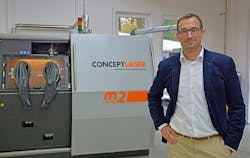Concept Laser launches laser additive manufacturing R&D center
IMAGE: Concept Laser head of development Florian Bechmann is shown with a LaserCUSING system, and says, "Safety aspects, automation and effective QA measures are paramount for us." (Image credit: Concept Laser)
Lichtenfels, Germany--Increased global demand for generative part manufacturing (also called laser additive manufacturing--LAM--or 3D printing) is expanding the activities for Concept Laser, which has opened a new development center or "company think tank". The 600 square meter R&D center will allow for expanded testing capacity with dedicated development equipment for LaserCUSING, in which finely pulverized metal is fused using a high-energy fiber laser. After cooling, the material solidifies. Component contour is achieved by directing the laser beam with a mirror deflection unit (scanner). Construction takes place layer by layer (with each layer measuring 15 to 100 microns thick) by lowering the bottom surface of the construction space, then applying and fusing more powder.
For development engineers, the center offers an optimal platform for process development, as well as for the development of new LAM systems, such as the recent LaserCUSING System X line 1000R in XXL format. Another important benefit is to facilitate "discrete innovations": this means that R&D activities can be carried out with clearly defined capacities while respecting bilateral confidentiality requirements.
Concept Laser, with its strong focus on high-quality, application-specific system solutions in the fields of medical and dental technology, the automotive industry, tool and mold construction, and the highly innovative aviation and aerospace sector, will intensify its proven three-phase product development process at the new location. "The number of test reports produced by our development department has already risen by 30% from 2012 to 2013," says Florian Bechmann, Head of Development at Concept Laser. "The new development center will raise our capabilities to a new level--in terms of time, as well as quality and quantity. As a technology leader, we want to live up to the market's expectations." Being a technology leader requires investment: for Concept Laser, this means that the entire annual surplus is being reinvested in research, development and growth.
The sector predicts a further growth spurt in terms of development. For instance, the range of lasers is being extended; an example being the upgrade from 400 to 1000 Watt. Furthermore, it has announced that in the future, 2, 4, or more lasers will operate in parallel in installation areas. This so-called "multi-laser technology" will significantly improve the speed of generative component construction. The Lichtenfels-based company does not only want to meet the average when it comes to the safety aspects, automation and quality assurance measures that underpin its development process; it wants to continue setting new standards.
Numerous application areas in medical engineering, turbine engineering or in the automotive industry are undergoing a paradigm shift away from technology with fixed forms toward generative 3D printing processes on an industrial level. The strongest drivers of this change in thinking are members of European markets, such as Astrium Space Transportation, which is part of the EADS Group, or the German Aerospace Center, pan-industrial EU projects, such as Amaze; however above all it is also companies from the NASA environment right through to large-scale American aircraft manufacturing. Moreover, Bechmann also emphasizes the clear advantages that LaserCUSING provides for sustainable, environmentally friendly production.
According to Bechmann, the decision to concentrate technical expertise in a central location was also motivated by the enormous increase in customer-specific solutions, which are usually subject to confidentiality. These sensitive projects arise from intensive customer relationships and, as sources of innovation, will be decoupled from the "normal operations" of the development center. According to Bachmann, "This will allow discrete innovations to be developed in the necessary seclusion and depth."
The development center bundles the functionalities that are relevant for the LaserCUSING. This provides for even better networking among the fields of optical systems, design, control technology, and software development. Development engineers are now in closer contact and can conduct tests very rapidly and better communicate the results.
The redesigned development laboratory now houses a larger metallography laboratory and materials testing area. This supports the growing trend of customers formulating special, application-specific requests related to the powder materials being used, which requests the system manufacturer must then translate into validated, certified processes. "These requirements relate to every facet of the areas of process design, quality assurance and safety, especially for reactive materials," says Bechmann. Concept Laser intends to further expand its recognized expertise in the area of materials and materials certification.
SOURCE: Concept Laser; http://www.concept-laser.de/en/press.html
